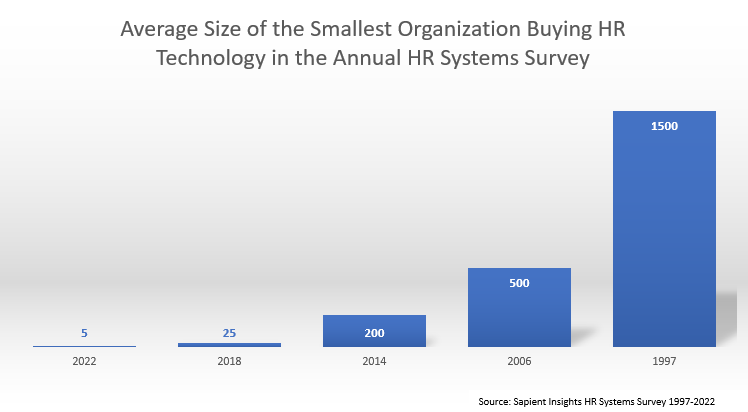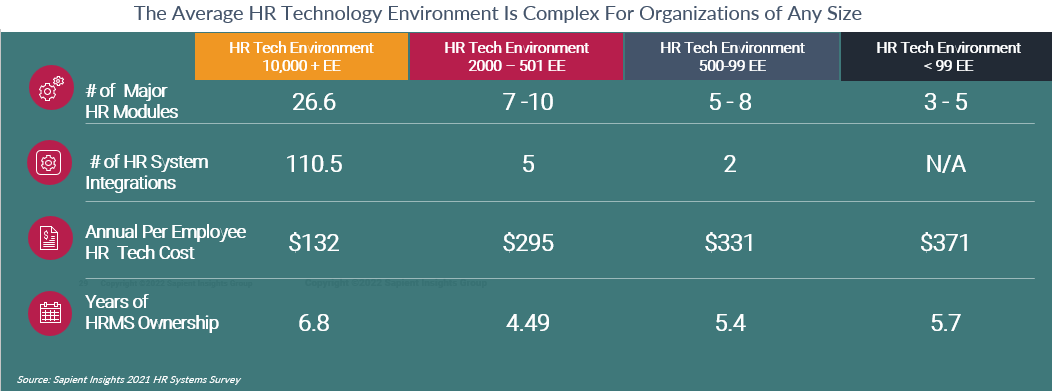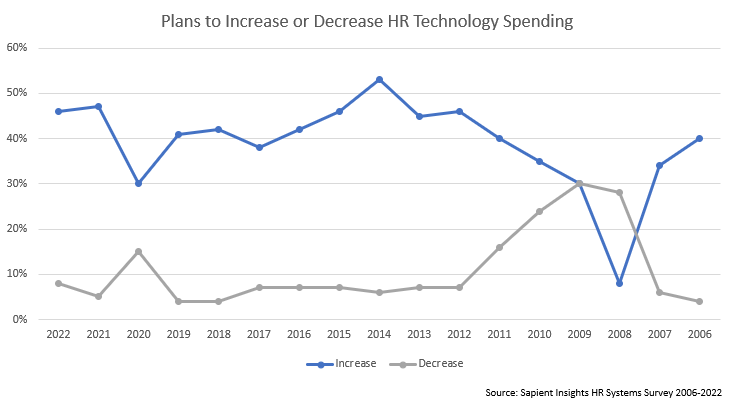In 1997, the economy was on an upswing, the song Macarena was still topping the charts, and a cloned sheep named Dolly was making headlines. In the tech world, Amazon was just two years old, and Google was still a year away from releasing its first search bar. To put this history into perspective, Sapient Insights’ youngest employee hadn’t even been born yet, the most up-to-date technology was still found at work, and the idea of an iPhone-spurred consumer-driven market was still a decade away.
Out of this environment, the first iteration of what we know today as Sapient Insights Annual HR Systems Survey Research was released as a mail-in survey to 25 forward-thinking organizations, including Pacific Bell, Intel and Bank of America. Under the brand of Hunter Group, Lexy Martin, the first survey author, embarked on a journey to understand the emerging trend of self-service HR: the novel idea of giving candidates, employees and managers access not only to data but also to tools that they could use to help make decisions and improve their work environments.
Two decades ago, employee-focused technology was such a new idea that buyers couldn’t even imagine the world we live in today. Some of the more memorable comments from that first research effort are worth sharing:
- Online benefits enrollment: “By keeping our benefit plans stable and standard, only [a small percent] of our workforce needs benefit enrollment. It’s just not a high-priority application.”
- Electronic paystub and benefit statements: “We will not provide these online because we believe these services should go to the employee’s home for family review.”
- Tracking skills and career paths: “We want to do this but cannot get agreement on what skills should be included [so automation is impossible].”
- Automating performance evaluations: “We just have too much variation in this process [to automate it].”
 Today, the Annual HR Systems Survey covers over 100 HR technology topics and reaches more than 5,000 people annually, focusing on being the “voice of the HR technology buyer.” In 25 years, we’ve captured data from almost 20,000 individual organizations covering 300 million employees. More importantly, the distance traveled from 1997 to today in the value and importance we place on workforce technology has grown exponentially.
Today, the Annual HR Systems Survey covers over 100 HR technology topics and reaches more than 5,000 people annually, focusing on being the “voice of the HR technology buyer.” In 25 years, we’ve captured data from almost 20,000 individual organizations covering 300 million employees. More importantly, the distance traveled from 1997 to today in the value and importance we place on workforce technology has grown exponentially.
Nothing illustrates this shift better than the declining number of organizations telling us that they are implementing HR technology to replace paper-based and manual HR processes. Digital-first is now a reality in HR, as business leaders turn to technology right out of the gate. In 2022, our smallest survey participants averaged fewer than five employees when purchasing their first HR application—a far cry from the 1,500-employee average in 1997.

While smaller and smaller organizations are buying HR technology, we’ve also seen the average number of applications or major modules purchased for enterprise use double in the last five years from 7.3 to 16.24 in 2021. Even the smallest of organizations are likely to own three to five applications to meet all of their employment needs, spending several hundred dollars annually per employee. Increasingly, organizations also find that these complex HR technology environments require hours of maintenance and upkeep as well as multiple levels of integrations to maximize their value.

No one is questioning the value of HR or workforce technology today. Instead, our survey respondents are telling us their businesses and employees are clamoring for more. Employees expect consumer-grade digital experiences that make their work and life easier. Business leaders request more people data every day as they face changing business models that require constant innovation.
Recent research on the human ability to plan and innovate found that our capability to recall memories impacts those skills greatly. In other words, we can’t look forward without first looking backward, which is why I’ve been so passionate about protecting this research since it was placed in my care over eight years ago. It’s hard to believe that the topic of greatest interest to readers when I took over the research in 2014 was movement to a cloud HRMS application. At the time, 70% of organizations still had an on-premise HRMS, but with aggressive vendor investments in cloud technology, our industry became one of the first enterprise-level applications to reach the cloud, ushering in a new era of 24/7 access and consumer-grade user experiences.
 Today, only 15% of organizations maintain an on-premise HRMS system. In most cases, this rapid innovation was a boon for business productivity and flexible employee work environments, but most experts agree that it also led to the growing syndrome of workplace burnout. In a digital-first world, knowing our history and understanding the impact of our decisions is necessary for us to reach the future with our humanity intact.
Today, only 15% of organizations maintain an on-premise HRMS system. In most cases, this rapid innovation was a boon for business productivity and flexible employee work environments, but most experts agree that it also led to the growing syndrome of workplace burnout. In a digital-first world, knowing our history and understanding the impact of our decisions is necessary for us to reach the future with our humanity intact.
Looking Ahead to 2023
HR technology budgets are known to be highly susceptible to the impact of external factors, such as economic growth or workforce migrations, leading us to predict that this year’s focus on a looming recession or economic slowdown would show up in decreasing spending plans for HR technology in 2023.
In contrast, it seems that business leaders may finally be learning from past mistakes because the bounce we saw in increased spending plans for 2022 is holding steady for 2023 at 45% of organizations. The talent market is still tight, unemployment remains at historically low levels, and smart businesses know their history.
Outside of the 2020 drop due to early uncertainty of the COVID-19 crisis, the last major reduction in HR technology spending plans was in the Great Recession of 2008 when we saw an almost 80% reduction in organizations planning to invest in HR technology from 2007 to 2008. At the height of that recession, 15.6 million people were unemployed in the U.S. and over 8 million had been laid off. Just 18 months later, by late 2010, 54% of large U.S. businesses were desperate to rebuild their workforces. By then organizations were plagued with outdated HR technology and overworked HR functions unable to meet the growing demand for talent. It took the market almost four years to reach the level of HR technology investments that was seen in pre-recession timeframes. For many organizations, the lack of talent and innovation bred insurmountable challenges, leading to such respected brands as Blockbuster and Blackberry disappearing into historical footnotes.

This year’s slight increase in plans to decrease spending in 2023 is confined to the smallest organizations, those below 500 employees, with just 35% of them planning to increase spending. The strongest HR technology spending growth is expected in organizations with more than 500 employees, where over 50% of organizations plan to increase HR technology budgets in 2023.
What is driving these increasing HR technology budgets, while we continue to hear about layoffs and softening economic factors? The HR technology community was pretty clear that their top goals were:
- Improving HR efficiency
- Acquiring and retaining top talent
- Improving HR data quality
These driving factors for increasing budgets outranked other goals such as improving employee experience, new business models, increased compliance requirements, or global expansion. These top three factors may be more connected than we realize, as organizations tackle the challenges created by the Great Resignation of 2021. We saw a 33% drop in survey respondents with over 10 years of experience in the HR technology field, mirroring what other industries are facing with a loss of both knowledge and expertise that is difficult to replace in critical roles.
We are thrilled that we’ll be able to dive deeper into spending plans and share all of our key findings from this year’s research in Las Vegas at the HR Technology Conference & Exposition keynote session on the morning of Sept. 15. Those will include:
- Top applications receiving increased spending in 2023
- Voice of the Customer, top 5 vendor ratings
- The buyer’s perception of the new Experience Platform
- If RFPs could talk what would they say? Buyers share their top RFP shortlists
- Respect is no longer an option for HR, so let’s change the conversation!
HR technology works at its best when it provides the framework through which balance can be achieved for both our workforces and businesses. Looking forward, HR technology may be facing its greatest challenge yet: The future will not be judged by cost savings and ease of use, but rather by value creation and workforce outcomes. In this new world, transparency will be expected and yet trust is paramount—and the responsibility for managing this balance is on the changing role of tomorrow’s HR leaders and technologists.
With a 25% increase in participation in the Annual HR Systems Survey this year, those of us who work on this project daily are humbled by the continued support and excitement of the community. The full report will be available for download in mid-October at SapientInsights.com, and we’ll be sharing more details throughout the year in articles here on HRExecutive.com. Let’s make the next 25 years amazing!
The post Risks and progress revealed by 25 years of continuous HR systems research appeared first on HR Executive.